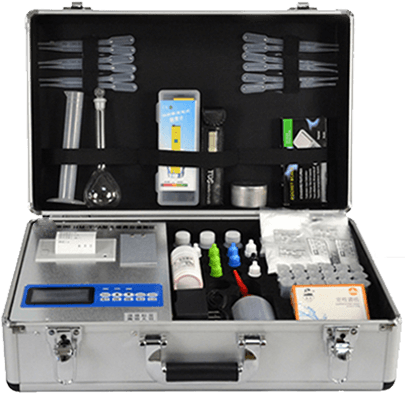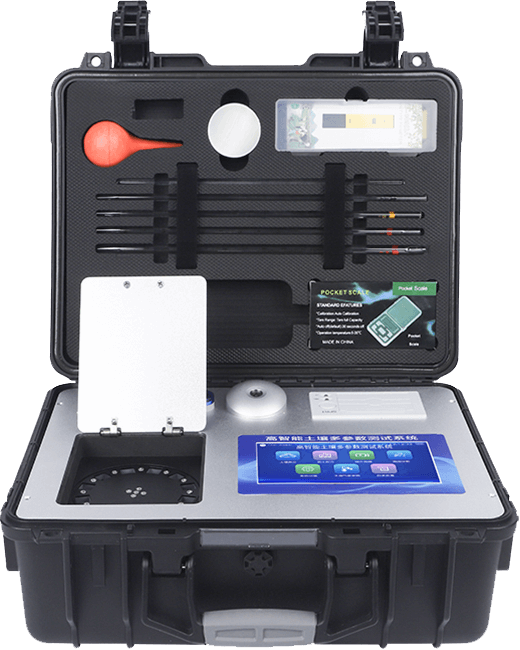
Soil Heavy Metal Rapid Testing Instrument
- Product Number:LD-ZSB
- Product Difference:12 detection channels for testing arsenic, lead, cadmium, chromium, mercury, nickel, aluminum, fluorine, titanium, selenium, iron, aluminum, zinc, manganese, copper, etc. in soil, fertilizer, crops, vegetables, fruits, water quality, food, and other samples
Product Introduction
Soil heavy metal pollution is becoming increasingly severe, leading to the accumulation of heavy metals such as cadmium, copper, arsenic, chromium, mercury, nickel, aluminum, fluorine, titanium, selenium, iron, zinc, manganese, and copper in the soil's topsoil layer. This has become one of the primary environmental issues facing us today.
Heavy metals in soil enter the food chain through accumulation in crops, posing a serious threat to human and animal health. The mining of non-ferrous metal ores, the discharge of industrial “three wastes” (wastewater, waste gas, and solid waste), the accumulation of heavy metal-containing waste, the use of wastewater for irrigation in agricultural production, and the improper use of agricultural chemicals can all lead to harmful heavy metal elements entering the soil directly or indirectly, resulting in severe exceedances of heavy metal content in soil, crops, fruits and vegetables, water quality, and aquatic products.
However, current heavy metal testing methods are slow, cumbersome, and require expensive equipment. In response to this situation, we have developed a rapid heavy metal testing method.
The soil heavy metal rapid testing instrument can rapidly and simultaneously determine the levels of arsenic, lead, cadmium, chromium, mercury, nickel, aluminum, fluorine, titanium, selenium, iron, zinc, manganese, and copper in samples such as soil, fertilizers, crops, vegetables, fruits, water quality, and food.
Product Features
Android smart operating system, main control chip uses ARM Cortex-A7, RK3288/4-core processor, main frequency 1.88Ghz, faster running speed, stronger stability.
4-wavelength professional test cold light source (red, blue, green, orange), with stable light source wavelengths. The light source maintains consistent performance during prolonged continuous operation without temperature drift, offering a lifespan of up to 100,000 hours, excellent reproducibility, and high accuracy.
Features a precision rotating colorimetric cell design for enhanced light source consistency, ensuring detection accuracy.
The instrument comes standard with Wi-Fi wireless uploading, 4G network transmission, and GPRS wireless remote transmission for rapid data uploading.
Dual-row 12 detection channels (solid-state design) allow for rapid testing of 12 samples at once, improving testing efficiency and reducing testing costs.
The instrument is equipped with both USB and Ethernet interfaces, features built-in high-capacity memory, and allows data to be copied to a USB drive at any time.
Equipped with a cloud platform, the instrument can selectively or batch-upload detection data wirelessly after connecting to a wireless network, facilitating long-term data management and visualization analysis for users.
Dual AC/DC power supply mode, with a built-in high-capacity rechargeable lithium battery that can operate continuously for over 10 hours when fully charged, and can also be connected to a car power source for charging.
Built-in calibration function during testing, intelligent constant current voltage regulation, and automatic light intensity calibration to ensure testing accuracy.
GPS functionality: records latitude and longitude locations during field operations, meeting the needs of special users.
High-strength PVC engineering plastic carry case design, durable and easy to carry.
The instrument features a Chinese-English language switch function, meeting export requirements.
Access historical data anytime via mobile phone by logging into the cloud platform.
Built-in clock function for convenient time recording and long-term historical traceability.
Built-in low voltage alert function to clearly indicate battery level during testing, preventing data drift. Also features power failure protection, automatically saving data upon power loss to prevent data loss.
The colorimetric cell section uses standard 1cm colorimetric cells, eliminating mechanical displacement and wear. The optical path testing positioning is accurate, effectively shielding external light interference, ensuring test results exceed national standard requirements.
Multiple user accounts with passwords can be set up. The user-friendly interface allows different users to freely add and edit test information, which can be saved for long-term use.
High-sensitivity 7-inch true-color touchscreen with more efficient and user-friendly operation, high-definition and high-interactivity display, significantly reducing the cumbersome operations and errors of traditional instruments.
The instrument system includes sample pretreatment operation videos. Various sample testing methods can be viewed by clicking the video module, eliminating the need for operators to self-study the manual. This provides convenient and rapid guidance, making it easy for newcomers to operate quickly.
The instrument is equipped with a new-generation high-speed thermal printer (no ribbon required), which prints the following information: testing unit, tester, testing item, channel number, absorbance, content (mg/kg), testing time, and QR code.
Product parameters
| Power Supply | AC 220±22V, DC 12V + 5V (the instrument's built-in lithium battery can also be powered by a car battery) |
| Power | ≤5W |
| Range and resolution | 0.001–9999 |
| Repeatability error | ≤0.03% (0.0003, potassium dichromate solution) |
| Instrument stability | ① No drift in displayed values within one hour (transmittance measurement) ② Drift in displayed values does not exceed 0.3% (0.003, transmittance measurement) or 0.001 (absorbance measurement) within two hours |
| Linear error | ≤0.1% (0.001, copper sulfate detection) |
| Sensitivity | Red light ≥4.5 ×10⁻⁵, blue light ≥3.17×10⁻³, green light ≥2.35×10⁻³ , orange light ≥2.13×10⁻³ |
| Wavelength range | Red light 680±2 nm, blue light 420±2 nm, green light 510±2 nm, Orange light 590±4 nm |
| Display resolution | 1024×600 |
| Vibration resistance rating | IP65 |
| Dimensions | 48×34.5×22 cm |
| Testing speed | Lead, arsenic, chromium, cadmium, mercury, five-item detection takes approximately 60 minutes (including soil sample pretreatment and reagent preparation) iron, zinc, manganese, copper, aluminum single-item detection takes approximately 30 minutes (including soil sample pretreatment and reagent preparation) |
| Main unit net weight | 5.2 kg |

 +86 19353291814
+86 19353291814
 +86 19353291814
+86 19353291814



